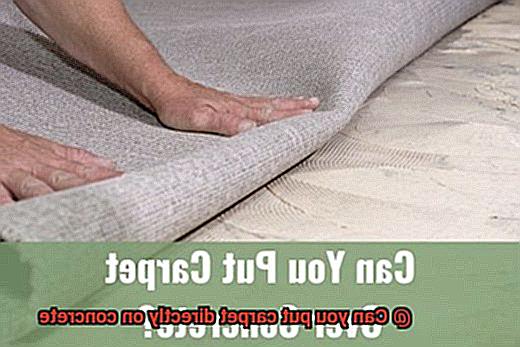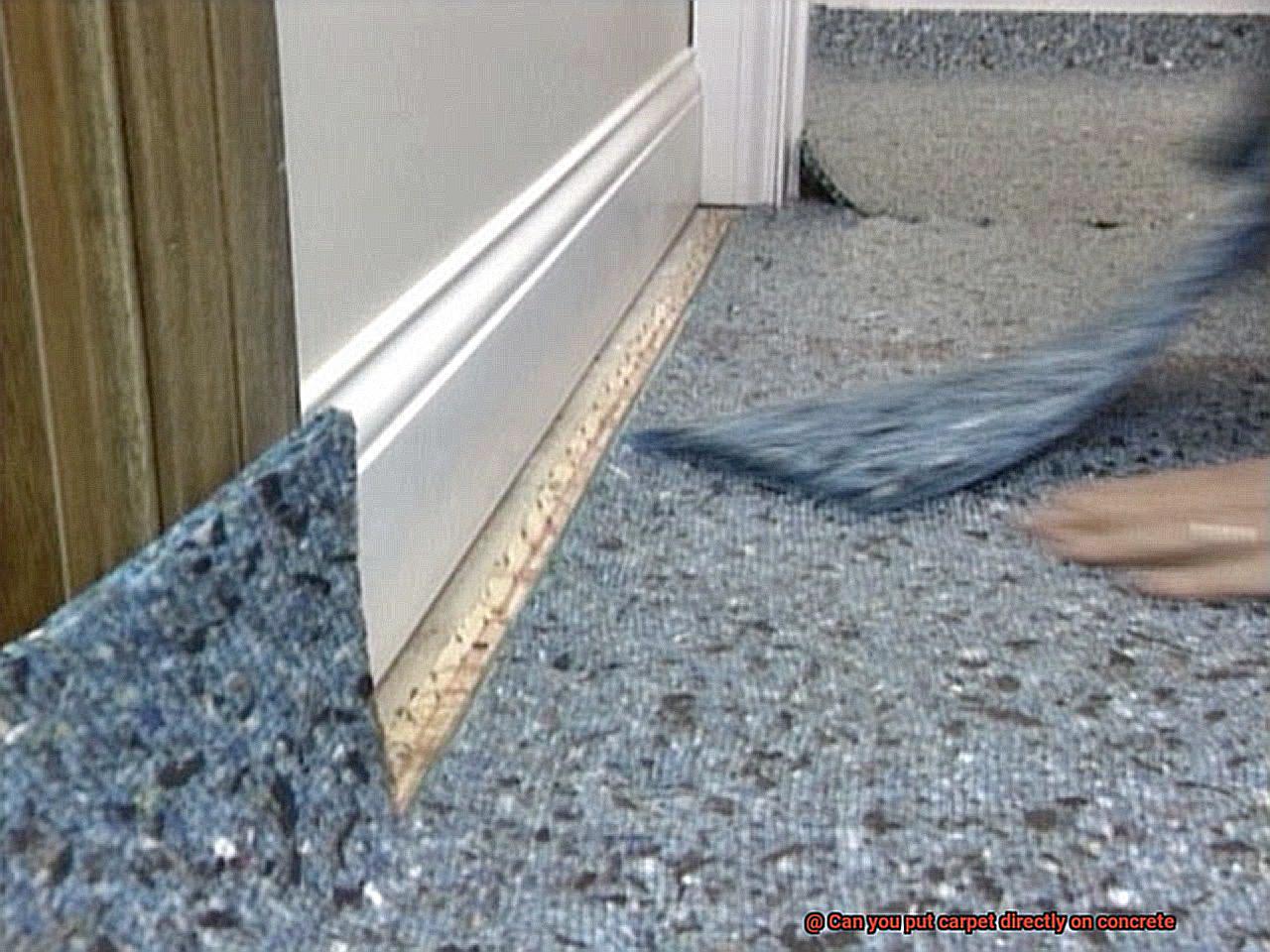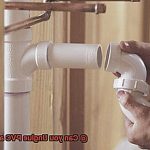Picture this: you step into a room that radiates sophistication, comfort, and a cozy ambiance. But alas. Your excitement deflates as you find yourself standing on chilly concrete floors. Quite the letdown, huh? Fear not, my friend. Today, we embark on a quest to uncover the truth behind the age-old question: Can you put carpet directly on concrete?
Now, it may seem counterintuitive to lay carpet directly on concrete. But hold onto your hats because this seemingly puzzling combination can work wonders for your humble abode or any space in need of a warm embrace. So let’s dive right in and explore the fascinating world where cold, hard concrete meets the soft caress of luxurious carpet fibers.

Contrary to what you might have heard through the grapevine, carpet can indeed be installed directly on concrete, transforming an unwelcoming space into a plush oasis. However, before we get ahead of ourselves, there are crucial factors to consider – moisture levels, surface consistency, and your choice of carpet type.
Throughout this captivating journey, we’ll unearth invaluable information about moisture barriers and adhesive options that will make your head spin (in a good way.). We’ll also emphasize the importance of prepping your subfloor before laying down that dreamy carpet. And let’s not forget about carpet padding – oh yes. We’ll delve into its insulating powers and how it plays a pivotal role in maximizing your comfort.
For those with an insatiable hunger for aesthetics (we see you.), fret not. Together, we’ll explore various carpet styles that will ignite your creativity without sacrificing coziness. From textures to designs – prepare to be inspired.
So whether you’re revamping a basement hideaway or contemplating an upgrade for your concrete floors (goodbye cold feet.), this blog post is here to serve as your ultimate guide. Get ready to shatter preconceived notions and embark on a journey that will forever change the way you perceive the dynamic relationship between concrete and carpet. Together, we’ll unlock the secret to transforming your space from barren to beautiful, one step at a time.
What You Need to Know Before Installing Carpet on Concrete
Contents
- 1 What You Need to Know Before Installing Carpet on Concrete
- 2 Moisture Considerations
- 3 Temperature Considerations
- 4 Assessing the Condition of the Concrete Surface
- 5 Using High-Quality Carpet Pad or Underlayment
- 6 Adhesive Selection for Carpet Installation on Concrete
- 7 Potential Warranty Issues
- 8 Regular Maintenance is Crucial for Carpets Installed on Concrete
- 9 Conclusion
There are several important factors to consider before diving into the installation process. In this article, we will explore the key points you need to know to ensure a successful and long-lasting carpet installation on concrete.
Assessing the Condition of the Concrete Surface:
Before installing carpet on concrete, it is crucial to evaluate the condition of the surface. Look out for cracks, moisture issues, or unevenness that may require attention. Addressing these concerns beforehand will prevent future problems and ensure a smooth installation process.
Moisture Management:
Moisture is a significant concern when installing carpet on concrete. Concrete tends to retain moisture, leading to mold and mildew growth if not addressed properly. Conducting a moisture test is essential to determine whether the concrete is dry enough for carpet installation. Use a moisture barrier, such as plastic sheeting or specialized products, to prevent moisture damage.
Choosing the Right Carpet Padding:
Carpet padding provides cushioning, support, and insulation against cold and noise. When installing carpet on concrete, use moisture-resistant padding to prevent mold and mildew growth. High-quality padding enhances comfort and extends carpet longevity.
Adhesive Considerations:
In some cases, adhesive or glue may be necessary to secure the carpet to the concrete surface. Follow manufacturer’s instructions carefully for proper application and drying time. Using adhesive designed for carpet installation on concrete ensures a secure and durable bond.
Professional Installation:
Proper installation techniques are crucial for success. Hire an experienced professional with concrete installation expertise. They will stretch the carpet tightly, seal seams properly, and deliver flawless results.
Regular Maintenance:
Maintaining your carpet installed on concrete is essential. Vacuum regularly, clean up spills promptly, and schedule professional deep cleanings. This prolongs carpet lifespan and prevents issues such as staining or odors.
Moisture Considerations
Today, we embark on an essential journey through the often overlooked realm of moisture considerations when installing carpet directly on concrete. Don’t underestimate the power of moisture, as it can wreak havoc and turn your carpet dreams into a wet nightmare. So, grab a warm beverage, settle in, and let’s explore the perils of neglecting moisture when laying carpet on concrete.
Mold and Mildew – The Undercover Carpet Assassins:
Imagine stepping into your cozy sanctuary, only to be met with a musty smell and unsightly dark patches on your carpet. Dreadful, isn’t it? Meet mold and mildew – the notorious culprits thriving in damp environments. When moisture penetrates through concrete and saturates your carpet, it provides the perfect breeding ground for these fungal intruders. Not only are they visually displeasing, but they also pose a serious health risk to those with respiratory conditions or allergies.
Carpet Delamination – Dismantling Your Flooring Dreams:
Envision strolling across your carpeted floor, only to stumble upon unsightly wrinkles or bulges. It’s not just an embarrassing moment – it’s a safety hazard. This phenomenon is called carpet delamination, and excessive moisture infiltrating the bond between your carpet backing and the concrete slab beneath is to blame. Over time, this infiltration weakens the adhesive bond, leading to possible detachment or unsightly deformities.
Efflorescence – The Enigma of White Powder:
If you’ve ever encountered a chalky white substance on concrete surfaces, you’ve witnessed efflorescence in all its glory. As moisture evaporates from the concrete, it leaves behind salt deposits that manifest as that unappealing powder. Now imagine installing your cherished carpet directly over efflorescence – it not only discolors your carpet but can also cause potential damage. Nobody wants a salt-and-pepper carpet, right?
Prevention is Key:
Now that we’ve uncovered the potential pitfalls of moisture when installing carpet on concrete, let’s delve into prevention. Here are some essential steps to ensure your carpet remains moisture-free and in pristine condition:
Temperature Considerations
When it comes to flooring, the allure of carpet lies in its ability to create a warm, inviting ambiance. However, when considering the installation of carpet directly on concrete, temperature becomes a crucial factor to address. As an expert in temperature considerations, I have delved into the depths of research to present you with a comprehensive guide. So, grab your coziest blanket and let’s embark on a journey to transform your space into a snug retreat.
Concrete’s Cold Embrace:
The inherent nature of concrete is one of coldness, particularly in spaces lacking proper heating or insulation. This chilly characteristic can cast a frosty spell on the environment, leaving occupants yearning for warmth, especially during colder months. But fret not, for carpet holds the key to banishing the cold.
Insulating Wonder: Carpet’s Role:
Carpet acts as a magnificent insulating material, skillfully trapping air between its luxurious fibers to create a pocket of warmth. Nevertheless, if the concrete beneath is exceptionally frigid, it may still influence the overall temperature within the room. To combat this challenge, additional measures are necessary.
Subfloor Savior:
A compelling solution lies in the installation of a subfloor before laying down the carpet. This ingenious layer, crafted from materials like plywood or foam, not only insulates but also regulates the temperature within the space. By forming a barrier against the penetrating cold of concrete, a subfloor creates an environment that is nothing short of comfortable and cozy.
Underpadding: A Cushioned Haven:
Another avenue to explore is the utilization of underpadding or underlay beneath the carpet. This plush cushioning layer not only enhances the longevity of your carpet but also acts as a formidable shield against temperature fluctuations. By incorporating underpadding, you elevate comfort while minimizing the adverse effects of cold concrete.
The Reality Check:
It is important to bear in mind that even with these additional measures, concrete floors may retain a hint of coolness compared to other flooring materials. Before reaching a final verdict, consider factors such as room usage and personal preferences. If temperature regulation stands as a paramount concern, alternative flooring options like hardwood or vinyl, which naturally exude warmth, may prove more suitable.
Assessing the Condition of the Concrete Surface
Hold your horses. Before you dive headfirst into the installation process, it’s essential to assess the condition of your concrete surface. This crucial step will unveil any potential issues that could throw a wrench in your carpet installation plans. Let’s embark on a thrilling journey to explore the vital factors you need to consider before laying down that plush carpet on concrete.
The Moisture Maze:
Moisture can be a stealthy enemy, silently seeping through concrete and wreaking havoc on your carpet. Fear not. We have a simple test up our sleeves – the plastic sheet test. Lay down plastic sheets on different areas of the concrete floor, securely taping the edges. Wait 24 hours and then unveil the underside. If you spot condensation or dampness, it’s a red flag of high moisture content in the concrete. Brace yourself for additional measures before embarking on that carpet installation adventure.
The Battle of Levelness:
Beware of the treacherous uneven surfaces that can trip up your carpet installation dreams. Armed with a trusty straightedge or level tool, go on a quest across different areas of the floor. Hunt down significant variations in height that could spell trouble for your carpet’s longevity. If you stumble upon noticeable uneven spots, it’s time to level the playing field before setting foot on that carpet.
Cracks and Damages: The Silent Villains:
Concrete floors often bear tiny cracks as battle scars, but fear not, these are usually harmless for carpet installation. However, keep an eye out for larger cracks or structural damages that could unleash chaos on your soon-to-be-carpeted sanctuary. Tame these villains before they cause further deterioration or pose a safety hazard.
Coatings and Sealants: Friends or Foes?
Take a closer look at any coatings or sealants gracing your concrete surface. Are they friend or foe to your carpet installation dreams? Some types of sealants and coatings may not play nice with carpet adhesives, compromising the performance and lifespan of your carpet. Prepare for battle by removing or properly preparing these obstacles before you embark on your carpet installation conquest.
Using High-Quality Carpet Pad or Underlayment
Don’t forget to bring along your trusty sidekick – a high-quality carpet pad or underlayment. These unsung heroes play a vital role in ensuring your carpeted concrete floors are not only comfortable but also durable and long-lasting. So, gear up and let’s dive into the world of high-quality carpet pads.
Comfort that Reigns Supreme:

Concrete surfaces may be hard and unforgiving, but with the right carpet pad or underlayment, you can transform them into a cushioned oasis. These padding layers provide the much-needed cushioning and support, turning every step into a heavenly experience that feels like walking on clouds.
Extending the Lifespan:
Like a true hero, high-quality carpet pads battle against wear and tear caused by foot traffic to protect your carpet’s integrity. By absorbing the impact of footsteps, these pads distribute weight evenly and reduce strain on carpet fibers. This not only enhances comfort but also extends the lifespan of your carpet, keeping it fresh and vibrant for years to come.
Insulation for All Seasons:
Concrete floors can send chills down your spine, especially during frigid winter months. But fear not. A top-notch carpet pad acts as a reliable barrier between the cold concrete and your feet. With insulation properties, these pads keep you warm and cozy while making the entire room feel more inviting.
Silence the Echoes:
Ah, the serenity of peace and quiet. Concrete floors are notorious for their echo-inducing nature, but with a high-quality carpet pad, you can silence those unwanted sounds. These pads absorb sound vibrations, reducing noise and echoes within the room. So go ahead, walk softly, and savor the tranquility of a noise-free environment.
Choosing the Perfect Sidekick:
When selecting a carpet pad or underlayment for your concrete floors, consider a few key factors. Look for pads specifically designed for concrete surfaces, as they are moisture-resistant and built to withstand the challenges posed by concrete. Additionally, balance comfort and insulation with practical considerations like door clearance by selecting the right thickness and density of the pad.
Adhesive Selection for Carpet Installation on Concrete
Today, we embark on a quest to unravel the mysteries of adhesive selection for carpet installation on concrete. Choosing the right adhesive may not be as glamorous as selecting the perfect carpet pattern, but it is the secret ingredient to a flawless and long-lasting installation. So, fasten your seatbelts and prepare to explore the key factors that will make your carpet stick like a champ. Let’s dive in.
Know Your Carpet Type:
Just like a symphony conductor needs the right baton, different carpets require specific adhesives to orchestrate their performance. Whether you’re dealing with luxurious plush carpets or trendy loop pile designs, consulting the manufacturer’s recommendations is your ticket to adhesive harmony. Unlock their secrets and watch your carpet installation reach new heights.
Assess the Concrete Condition:
Before you start playing with adhesives, inspect your concrete canvas carefully. Is it a pristine masterpiece with a glass-like smoothness? Or does it bear battle scars in the form of cracks and imperfections? If it’s the former, a standard adhesive should do the job splendidly. However, if your concrete tells tales of past tribulations, opt for a specialized adhesive that can fill in gaps and level out unevenness. Give your carpet a rock-solid foundation and let it shine.
Don’t Let Moisture Rain on Your Parade:
Moisture can be the villain that threatens your carpet installation’s success. No one wants a soggy surprise or adhesive failure ruining their hard work. Thus, ensure your concrete surface is bone-dry before proceeding. Employ sophisticated moisture tests like calcium chloride or relative humidity tests to ensure moisture levels are within acceptable limits. Should moisture persist, call upon the powers of moisture barriers or moisture-resistant adhesives to protect your precious carpet from harm.
The Temperature Game:
Just like performers on a stage, adhesives have their temperature preferences. Extreme heat or cold can throw them off their game. Therefore, select an adhesive that can withstand the scorching heat or freezing chill of your environment. Don’t let weather-related woes become the villain in your carpet’s story.
Potential Warranty Issues
Embarking on the journey of installing carpet directly on your concrete floor is an exciting endeavor. However, before you dive into this adhesive adventure, it’s crucial to address potential warranty issues. Don’t get caught in a sticky situation where your warranty becomes null and void. Let’s explore why it’s essential to follow the manufacturer’s guidelines and hire a professional carpet installer. Your carpet’s longevity depends on it.
Manufacturer’s Guidelines: The Conductor of Perfection
Like a skilled conductor, carpet manufacturers provide specific guidelines and recommendations for installation. Ignoring these instructions can lead to a warranty catastrophe. Pay close attention to details such as moisture barriers, proper pad selection, and installation techniques. Remember, the manufacturer knows the secrets to a flawless installation.
Moisture Matters: Keeping Mold at Bay
Concrete is a thirsty beast that can absorb ground moisture, creating a breeding ground for mold and mildew beneath your carpet. To evade moisture-related warranty issues, seal your concrete diligently and address any existing moisture problems. Consider using moisture barriers or applying waterproofing sealants to keep your carpet dry and content.
Pad Perfection: Support Equals Durability
The key to a long-lasting carpet lies in the quality of the pad. Don’t skimp on this critical component. Using an incompatible or substandard pad can accelerate wear and tear, potentially voiding your warranty. Each carpet manufacturer prescribes specific pad types and thicknesses to ensure proper support and durability. Take the time to read and follow these guidelines – your carpet will be eternally grateful.
The Art of Installation: Leave It to the Pros
Installing carpet directly on concrete demands finesse and expertise. Improper installation techniques can result in unsightly wrinkles, troublesome buckling, or other issues that may void the warranty. This is where the professionals shine. Entrusting your installation to a knowledgeable carpet installer ensures compliance with requirements and minimizes the risk of warranty woes. Sit back, relax, and let them work their magic.
Document Your Carpet Journey: Evidence Is Key
The power of documentation should never be underestimated. Maintain records of your carpet purchase, installation, and any maintenance or repairs throughout its lifespan. These documents serve as your armor in case of warranty issues. Having proper evidence streamlines the claim process and potentially resolves any problems with the manufacturer. Remember, evidence is the key to unlocking warranty bliss.
Regular Maintenance is Crucial for Carpets Installed on Concrete
You’ve successfully installed carpet directly on concrete, and now it’s time to embark on a new adventure – maintaining its beauty and longevity. Just like conducting a symphony, regular maintenance is crucial to ensure your carpet hits all the right notes. Let’s dive into why regular maintenance is essential for carpets installed on concrete.
Carpets installed on concrete are magnets for dust, dirt, and debris. But fear not. Regular vacuuming is your secret weapon in the battle against surface-level dirt. Make it a habit to vacuum at least once a week to keep your carpet looking clean and fresh. In high-traffic areas like hallways or entryways, up the ante by vacuuming more frequently or using a carpet sweeper to pick up those pesky dust bunnies.
But wait, there’s more. Regular vacuuming not only keeps your carpet pristine but also improves indoor air quality by removing allergens. Dust and dirt may be invisible enemies, but by eliminating them, you’re creating a healthier environment for you and your loved ones. It’s a win-win situation.
Of course, spills and stains happen – it’s a fact of life. But prompt action is key to preventing stains from becoming permanent residents on your carpet. Grab a clean cloth or paper towel and blot the spill as soon as possible. Don’t forget to use a carpet cleaner specifically designed for your type of carpet. This ensures effective stain removal without causing any damage.
Now, let’s dive deeper – literally. Deep cleaning your carpet regularly is highly recommended. Whether you opt for a steam cleaner or hire professionals specializing in carpets installed on concrete, deep cleaning works wonders. It eliminates embedded dirt, stains, and odors that may not be visible on the surface. Think of it as a spa day for your carpet – rejuvenating its fibers and restoring its appearance.
Remember, each carpet is unique, so it’s crucial to follow the manufacturer’s guidelines for deep cleaning. Some carpets may require specific cleaning methods or products to maintain their integrity. By staying in tune with these recommendations, you’ll ensure your carpet continues to perform at its best.
Regular maintenance also involves addressing any issues that may arise. Loose seams or tears? Don’t let them linger – tackle them promptly to prevent further damage and ensure your carpet’s longevity.
VdwHDZiuvLc” >
Conclusion
Yes, you can indeed put carpet directly on concrete. In fact, it is a common practice in many homes and commercial spaces. However, there are a few important factors to consider before doing so.
Firstly, it is crucial to ensure that the concrete surface is clean, dry, and free from any debris or imperfections. This will provide a smooth and stable foundation for the carpet installation.
Secondly, it is recommended to use a moisture barrier or underlayment between the concrete and the carpet. This helps to prevent any potential moisture issues that may arise from the concrete slab.
Additionally, using a good quality carpet pad is essential for comfort and durability. The pad provides cushioning and insulation, making your carpet more comfortable to walk on and extending its lifespan.
Lastly, professional installation is highly recommended when installing carpet directly on concrete. They have the expertise and tools necessary to properly secure the carpet and ensure a seamless finish.
So, yes, you can absolutely put carpet directly on concrete with proper preparation and installation techniques.





